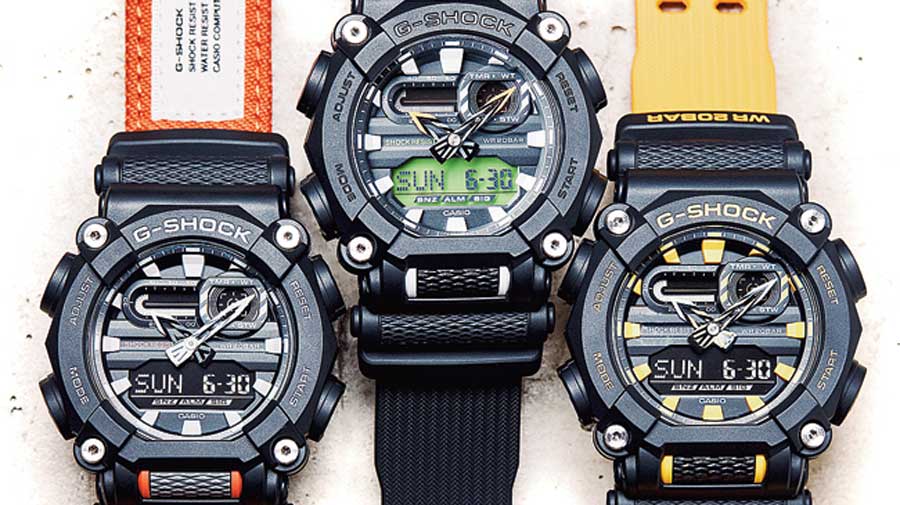The world of watches has gone casual, with smartwatches turning up on wrist after wrist. It’s also worth remembering that smartwatch brands are pushing their products more, advertising more to get noticed. Traditional watches are very much around and selling quite well. One brand has been enjoying a surprisingly steady following — Casio with its G-Shock models. There are blogs dedicated to the watch and musician John Mayer is a fan of the watch. In fact, the Slow Dancing In A Burning Room singer is a self-proclaimed “watch guy”. Since its arrival in 1983 (in India, it has been available for 25 years), the G-Shock has been in the wardrobes of Eminem to Francis Ford Coppola. What’s making the G-Shock tick, we asked Sachin Sharma, head of marketing, Casio India.
Inspiration for G-Shock
The core inspiration behind G-Shock watches has remained constant over the years to be an epitome of robustness, innovation and multi-functionality. Enthusiasts have been wearing the watches through hard knocks and falls during everyday use, playing sports or extreme outdoor conditions for 38 years now. The original DNA of G-Shock has remained the same, which is tough at its core yet we have seen G-Shock constantly evolve not just in meeting its core product promise but integrating itself as an essential youth culture brand.
There are seven elements
Besides toughness, G-Shock watches also encompass six other elements — electric shock resistance, gravity resistance, low-temperature resistance, vibration resistance, water resistance and shock resistance. Each watch is designed to perform under duress with a wide range of materials, which contribute to these in varying measures across the product line. Guided by a “Triple 10” development concept, all G-Shock watches were made to meet with 10-metre free-fall endurance, 10-bar water resistance and 10-year battery life.
In the era of smartwatches
G-Shock has increasingly focused on smartphone integration with essential functions across its range which can measure fitness, time adjustment and notifications and calibrating information from its watches. We are the only lifestyle watch brand in India that has focused actively on building a strong connection with the relevant youth subcultures and have actively encouraged a culture of toughness and never-say-die attitude amongst the youth of India.
India, a price-conscious market
Each G-Shock watch offers a sharply differentiated proposition at a price point that gives the customer a premium lifestyle product that is extremely high in value. The sheer balance between the two aspects has endeared itself to the Indian customer who is a value-conscious buyer yet is willing to pay a premium for a product that is high on quality, design and build. This has led to G-Shocks building a formidable following in India over the last 25 years with a lot of customers upgrading to more expensive G-Shock’s over a lifecycle of usage.
Market in India
With India on a growth trajectory in terms of growth of organised retail, lifestyle spends, increasing urbanisation and high on the demographic dividend, G-Shock has already cemented itself as the best performing youth lifestyle watch brand in India. We only expect this to grow further.
Millennials and G-Shock
With a dedicated line of youth fashion watches that focuses on being extremely relevant in the streetwear space, G-Shock is extremely popular amongst the millennials for pairing it with multiple outfits and sneakers. At the same time with a dedicated line of premium watches in the Master of G range, MTG and special edition watches, G-Shock offers a wide range of options for its loyal customers who are also ardent collectors.

Kikuo Ibe and his team came up with the G-Shock Picture: Casio
How it started
Birth: G-Shock was born from the belief that there could be a watch that would not break. Formed to handle its development, Project Team Tough came up with over 200 prototypes for performance testing, and spent over two years developing the structure and improving the parts. In 1983 the project was completed.
Chink in the armour: The team first assumed that it would be best to cover the entire watch with a soft material. But it didn’t work. A watch breaks no matter how much shock-absorbent rubber adheres to the exterior of the case. A five-step shock absorbent structure that protected the module with five cushioning materials was devised. But there was a problem with the strength of the electronic parts. Strengthening one broken part led to breakage of another. To test, developers would drop reinforced parts out of the window of a third-floor men’s room and watch it break 10 metres below.
Miracle moment: Kikuo Ibe, the engineer responsible for the external design of watches at the time, came up with a solution. Outside the laboratory he found a child bouncing a rubber ball. “If you could attach a watch to that ball it will endure shocks.” The idea was explored.

Sachin Sharma, head of marketing, Casio India Picture: Casio
Evolution of functions
1983: 200m water resistance
1996: EL backlight allows exceptional visibility in dark places
2002: Solar power
2017: Low-temperature resistance… as low as minus 20 degree Celsius
2018: Bluetooth plus radio-controlled solar-powered timekeeping










